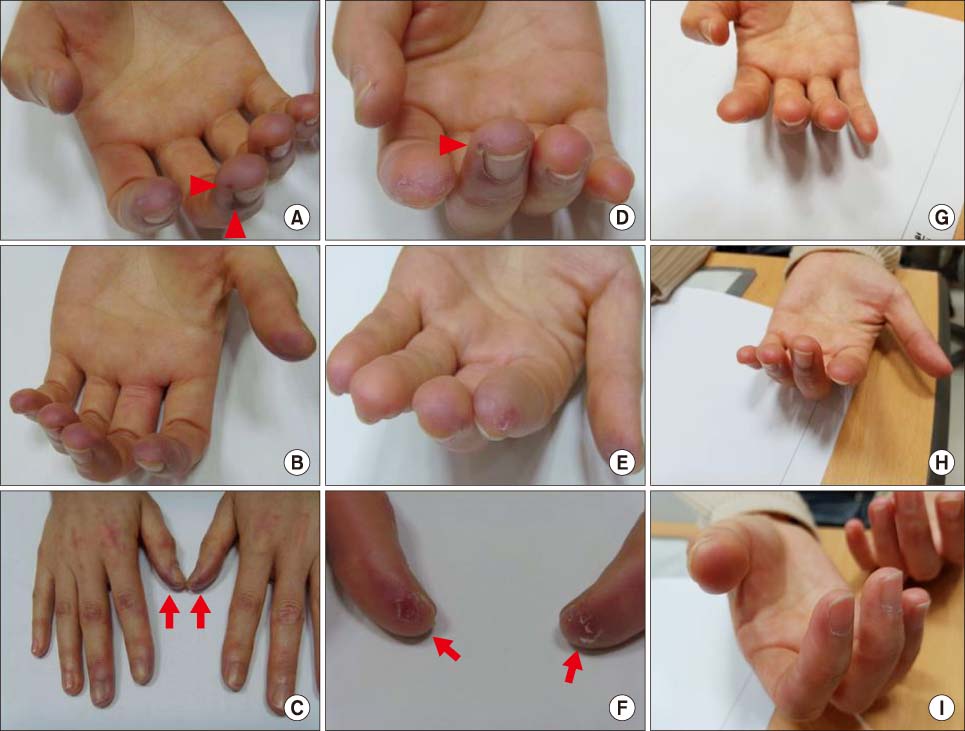J Rheum Dis.
2018 Jul;25(3):203-206. 10.4078/jrd.2018.25.3.203.
Case of Raynaud Syndrome after the Use of Methimazole
- Affiliations
-
- 1Division of Rheumatology, Department of Internal Medicine, Kosin University Gospel Hospital, Busan, Korea.
- 2Division of Rheumatology, Department of Internal Medicine, Pusan National University Hospital, Busan, Korea.
- 3Department of Surgery, Kosin University Gospel Hospital, Busan, Korea. gskjh6462@gmail.com
- KMID: 2415609
- DOI: http://doi.org/10.4078/jrd.2018.25.3.203
Abstract
- Raynaud syndrome is a medical condition that causes pain, numbness, and changes in skin color at the distal extremities. Raynaud syndrome can be subdivided into primary Raynaud's and secondary Raynaud's. The former is diagnosed when the cause is unknown and the latter is caused by an underlying condition, such as connective tissue diseases, injury, smoking, or certain medications. Both cancer chemotherapy and β-blockers are relatively common causes of Raynaud syndrome but there are no reports of its association with methimazole administration. The authors encountered a 43-year old woman with hyperthyroidism who developed digital ulcers associated with Raynaud syndrome after a methimazole treatment. Her digital ulcers and Raynaud syndrome were improved after methimazole was replaced with propylthiouracil and conventional therapy. This paper reports this case along with a review of the relevant literature.
Keyword
MeSH Terms
Figure
Reference
-
1. Herrick AL. The pathogenesis, diagnosis and treatment of Raynaud phenomenon. Nat Rev Rheumatol. 2012; 8:469–479.
Article2. Silman A, Holligan S, Brennan P, Maddison P. Prevalence of symptoms of Raynaud's phenomenon in general practice. BMJ. 1990; 301:590–592.
Article3. Suter LG, Murabito JM, Felson DT, Fraenkel L. The incidence and natural history of Raynaud's phenomenon in the community. Arthritis Rheum. 2005; 52:1259–1263.
Article4. Wigley FM, Herrick AL, Flavahan NA. Raynaud's Phenomenon: A Guide to Pathogenesis and Treatment. New York, NY: Springer New York;2015. p. 21.5. Kim HS. The efficacy of nailfold capillaroscopy in patients with Raynaud's phenomenon. J Rheum Dis. 2015; 22:69–75.
Article6. Davidson B, Soodak M, Neary JT, Strout HV, Kieffer JD, Mover H, et al. The irreversible inactivation of thyroid peroxidase by methylmercaptoimidazole, thiouracil, and propylthiouracil in vitro and its relationship to in vivo findings. Endocrinology. 1978; 103:871–882.
Article7. Kwak MK, Kim SR, Park JW, Han SJ, Kim MJ, Jin SY, et al. Methimazole-induced acute cholestatic hepatitis in a patient with history of simvastatin-induced liver injury. Soonchunhyang Med Sci. 2014; 20:163–167.
Article8. Cooper DS. Antithyroid drugs. N Engl J Med. 2005; 352:905–917.
Article9. Block JA, Sequeira W. Raynaud's phenomenon. Lancet. 2001; 357:2042–2048.
Article10. LeRoy EC, Medsger TA Jr. Raynaud's phenomenon: a proposal for classification. Clin Exp Rheumatol. 1992; 10:485–488.11. Maverakis E, Patel F, Kronenberg DG, Chung L, Fiorentino D, Allanore Y, et al. International consensus criteria for the diagnosis of Raynaud's phenomenon. J Autoimmun. 2014; 48-49:60–65.
Article12. Khouri C, Blaise S, Carpentier P, Villier C, Cracowski JL, Roustit M. Drug-induced Raynaud's phenomenon: beyond β-adrenoceptor blockers. Br J Clin Pharmacol. 2016; 82:6–16.
Article13. Thong HY, Chu CY, Chiu HC. Methimazole-induced antineutrophil cytoplasmic antibody (ANCA)-associated vasculitis and lupus-like syndrome with a cutaneous feature of vesiculo-bullous systemic lupus erythematosus. Acta Derm Venereol. 2002; 82:206–208.
Article14. Ajaz Y, Matto S. Carbimazole induced ANCA positive vasculitis. BJMP. 2014; 7:e712.15. Hosoi K, Makino S, Yamano Y, Sasaki M, Takeuchi T, Sakane S, et al. Cryofibrinogenemia with polyarthralgia, Raynaud's phenomenon and acral ulcer in a patient with Graves' disease treated with methimazole. Intern Med. 1997; 36:439–442.
- Full Text Links
- Actions
-
Cited
- CITED
-
- Close
- Share
- Similar articles
-
- Methimazole-Induced Insulin Autoimmune Syndrome in a Korean Patient with Graves’ Disease Treated with Propylthiouracil: a Case Report and Literature Review
- A case of Methimazole-Induced Cholestatic Jaundice With Agranulocytosis
- Anti-tuberculosis Treatment-Induced Insulin Autoimmune Syndrome
- Ensulin Autoimmune Syndrome in a Patient with Methimazole-Treated Graves' Disease: A Case report
- Clinical Study on Raynaud's Phenomenon


